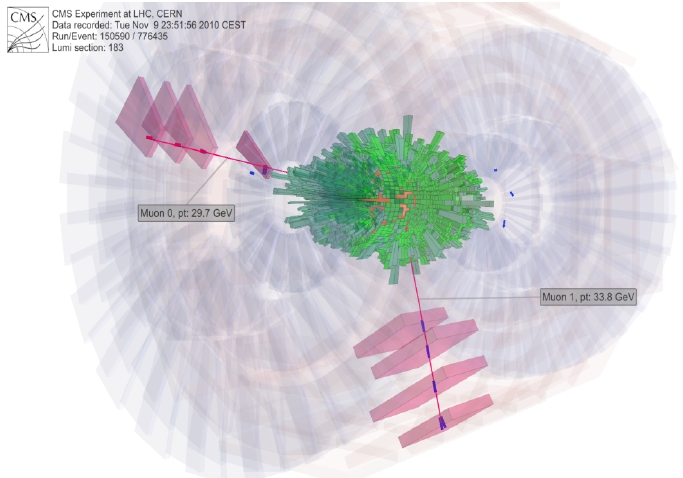Heavy ion collisions are not the reason why the CMS detector was built. When two nuclei of lead or gold collide at very high energy, the result involves simply too much information for a subnuclear physicist's taste. Already two protons colliding head-on are much more than a particle physicist would like to have: in fact, what one observes in a proton-proton collision when a really hard collision is generated, such as one between a quark in one proton and a quark in the other, is the sum of the wanted, interesting process, and a mess deriving from the recombination into light hadrons of the remainder of the two original protons. Imagine what happens when there is a very hard parton interaction in the middle of the softer interaction of hundreds of nucleons: a mess multiplied by the square of the number of nucleons!
Despite the complication of heavy ion collisions, it is interesting to study them in search for the same kind of processes that we usually look for in "simple" proton-proton collisions. For one thing, it gives us confidence that our detector works well even in those extreme conditions. You should remember that the LHC has so far ran proton-proton collisions at a rate two orders of magnitude smaller than that of design. When 20 hard proton-proton collisions will finally occur every 25 nanoseconds in the core of CMS and ATLAS, the detector "occupancy" -or let's just say the rate of particles crossing the detector elements- will be not much different from the one happening today with the collision of heavy ion nuclei.
Because of this, and because of more subtle physics reasons connected to the complex dynamics of hot nucleus-nucleus collisions, observing Z boson decays is very interesting. Look at the one below, for instance: two muons most likely originated from a Z boson are easily detected by the CMS detector. And Z decays to electron-positron pairs have similarly been observed with ease!
 The CMS detector in the graph above is seen "almost transparent", in order to highlight the energy deposits of particles in the calorimeter system (green bars) and just two energetic muons, observed in the four outer muon stations (only the chambers detecting the muons signals are shown, as pink boxes). Despite the mess in the calorimeter, the Z decay products are as evident as in the less complex proton-proton collisions.
The CMS detector in the graph above is seen "almost transparent", in order to highlight the energy deposits of particles in the calorimeter system (green bars) and just two energetic muons, observed in the four outer muon stations (only the chambers detecting the muons signals are shown, as pink boxes). Despite the mess in the calorimeter, the Z decay products are as evident as in the less complex proton-proton collisions. It should be remembered that it is the ALICE experiment the one which was built at the LHC with the specific goal of studying heavy ion collisions. However, it now appears evident that CMS, built with a totally different goal in mind, will provide strong competition in that field of physics too, thanks to its extreme versatility. It will be interesting to see the physics output of ALICE in the forthcoming weeks. Stay tuned for a wealth of new information that the LHC is providing in heavy nucleus collisions as well!





Comments